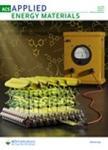版权所有:内蒙古大学图书馆 技术提供:维普资讯• 智图
内蒙古自治区呼和浩特市赛罕区大学西街235号 邮编: 010021

作者机构:Department of Chemical Engineering & Biotechnology National Taipei University of Technology No. 1 Section 3 Zhong-Xiao E. Road Taipei City10608 Taiwan Department of Optoelectronic Engineering National Dong Hwa University No. 1 Section 2 Da Hsueh Road Shoufeng Hualien97401 Taiwan
出 版 物:《ACS Applied Energy Materials》 (ACS Appl. Ener. Mat.)
年 卷 期:2024年第7卷第11期
页 面:4761-4767页
核心收录:
基 金:National Science Council and National Dong Hwa University Taiwan supported this research under contract MOST 111-2221-E-259-004-MY3. This work was also supported by the National Natural Science Foundation of China and Shanghai Jiao Tong University China through grant nos. 22109096 WF220528005 and ZXDF280001/024 respectively. The authors further acknowledge the technical support from Precision Analysis and Material Research Center National Taipei University of Technology for the characterization of the optical property of Bi:AgS/ZnO NRs and AgS/ZnO NRs by means of UV\u2013vis\u2013NIR spectroscopy. 2 2
摘 要:Trivalent bismuth (Bi3+) is put forward for the first time as a multifunctional dopant to tailor the optoelectronic property of silver sulfide (Ag2S), which is known as a promising photoelectrode candidate in view of its narrow band gap of ∼1.1 eV comparable to that of its toxic PbS counterpart. The introduction of Bi3+ into Ag2S gives rise to Bi:Ag2S to harvest light with a photon energy even lower than 1.1 eV via providing additional energy levels within its band gap. The electrical conductivity of Bi:Ag2S is also improved via offering extra free electrons to increase the carrier concentration to facilitate the transport of photoexcited electron-hole pairs. As an additional result of such increment in electron density is the Fermi level of Bi:Ag2S closer to its conduction band edge, leading to its potential difference with respect to that of the sulfide (S2-) and sulfite (SO32-) redox couples present in large quantity in industrial wastewater markedly amplified. More importantly, the degree of surface band bending is thereby well-strengthened to promote the separation of the photogenerated electron-hole pairs, which is further reinforced by depositing Bi:Ag2S on the zinc oxide nanorods (ZnO NRs) to form a Bi:Ag2S/ZnO NR heterojunction. The synergistic effect of the aforesaid enhancements renders the hydrogen evolution rate over Bi:Ag2S/ZnO NRs largely accelerated, as evidently manifested in its photocurrent density achieving 7 mA cm-2, far exceeding those reported for additional Ag2S-based photoelectrodes in the literature, of which the great promise is in view of such outperformance well-corroborated. © 2024 American Chemical Society.